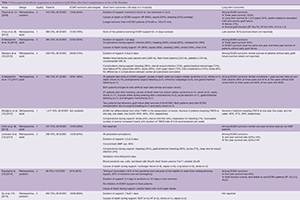Extracorporeal membrane oxygenation as treatment of graft failure after heart transplantation
Abstract
Heart transplantation (HTx) is a valuable option in eligible patients with end-stage heart failure. The most significant complication in the immediate post-operative period is early graft failure (EGF), with a mean incidence of 20–25%. EGF is a major risk factor for death and accounts for 40–50% of early mortality after HTx. Despite the use of inotropes, EGF may persist and require temporary mechanical circulatory support. Extracorporeal membrane oxygenation (ECMO) has been investigated over the years and has proved to be a reliable strategy in patients with EGF after HTx. This study aims to review the contemporary literature on this topic. Considering short-term outcomes, 45–80% of patients were discharged alive from hospital. Duration of support is variable, with a mean duration of 4–8 days. Cannulation strategy and device selection have no differences with respect to short-term outcomes. The main causes of death are multi-organ failure, bleeding, heart failure, stroke and sepsis. Considering long-term outcomes, ECMO survivors appear to have similar survival rates to HTx patients who did not experience EGF. Also, ECMO-treated EGF, among survivors, has no detrimental effect for graft function. In conclusion, ECMO is a reliable therapeutic option to support patients with severe graft failure after HTx, providing adequate support with either central or peripheral arteriovenous cannulation. Further studies will be needed to establish the correct threshold for ECMO support and to provide long-term results.
Cover






